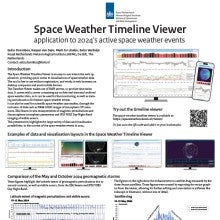Space Weather Timeline Viewer - application to 2024's active space weather events
Eelco
Doornbos
Royal Netherlands Meteorological Institute (KNMI)
Poster
The Space Weather Timeline Viewer, available at https://spaceweather.knmi.nl/viewer/, can be used to give a visual overview of a wide variety of space weather data sources. During the last year of active space weather, the timeline viewer tool has proven to be very useful, not only for monitoring real-time data streams as events unfolded, but also for post-event assessment of forecast products, and for assessments of less-often used scientific observations. The flexibility of the timeline viewer also contributes to making comparisons between events across the years, and helps to illustrate observational gaps.
Data from the May 10-11 and October 10-11 2024 geomagnetic storms shows the timing and locations of peak magnetic field perturbations, overhead aurora reaching 40 degrees magnetic latitude as seen in VIIRS Day-Night-Band satellite remote sensing in relation to citizen scientist observations, strong heating and cooling of the upper atmosphere seen in measurements of satellite drag, as well as extreme variations in the ionosphere.
Data from the May 10-11 and October 10-11 2024 geomagnetic storms shows the timing and locations of peak magnetic field perturbations, overhead aurora reaching 40 degrees magnetic latitude as seen in VIIRS Day-Night-Band satellite remote sensing in relation to citizen scientist observations, strong heating and cooling of the upper atmosphere seen in measurements of satellite drag, as well as extreme variations in the ionosphere.

Poster PDF
Poster category
Geospace/Magnetosphere Research and Applications
Meeting homepage